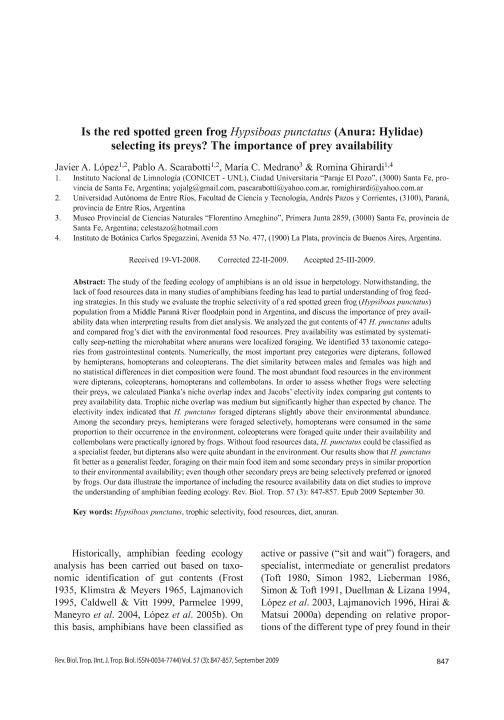Mostrar el registro sencillo del ítem
dc.contributor.author
Lopez, Javier Alejandro

dc.contributor.author
Scarabotti, Pablo Augusto

dc.contributor.author
Medrano, María Celeste

dc.contributor.author
Ghirardi, Romina

dc.date.available
2020-04-22T22:28:38Z
dc.date.issued
2009-09
dc.identifier.citation
Lopez, Javier Alejandro; Scarabotti, Pablo Augusto; Medrano, María Celeste; Ghirardi, Romina; Is red spotted green frog (Hypsiboas punctatus, Anura: Hylidae) selecting its preys? The importance of prey availability; Revista de Biología Tropical; Revista de Biología Tropical; 57; 3; 9-2009; 847-857
dc.identifier.issn
0034-7744
dc.identifier.uri
http://hdl.handle.net/11336/103392
dc.description.abstract
The study of the feeding ecology of amphibians is an old issue in herpetology. Notwithstanding, the lack of food resources data in many studies of amphibians feeding has lead to partial understanding of frog feeding strategies. In this study we evaluate the trophic selectivity of a red spotted green frog (Hypsiboas punctatus) population from a Middle Paraná River floodplain pond in Argentina, and discuss the importance of prey availability data when interpreting results from diet analysis. We analyzed the gut contents of 47 H. punctatus adults and compared frog?s diet with the environmental food resources. Prey availability was estimated by systematically seep-netting the microhabitat where anurans were localized foraging. We identified 33 taxonomic categories from gastrointestinal contents. Numerically, the most important prey categories were dipterans, followed by hemipterans, homopterans and coleopterans. The diet similarity between males and females was high and no statistical differences in diet composition were found. The most abundant food resources in the environment were dipterans, coleopterans, homopterans and collembolans. In order to assess whether frogs were selecting their preys, we calculated Pianka?s niche overlap index and Jacobs? electivity index comparing gut contents to prey availability data. Trophic niche overlap was medium but significantly higher than expected by chance. The electivity index indicated that H. punctatus foraged dipterans slightly above their environmental abundance. Among the secondary preys, hemipterans were foraged selectively, homopterans were consumed in the same proportion to their occurrence in the environment, coleopterans were foraged quite under their availability and collembolans were practically ignored by frogs. Without food resources data, H. punctatus could be classified as a specialist feeder, but dipterans also were quite abundant in the environment. Our results show that H. Punctatus fit better as a generalist feeder, foraging on their main food item and some secondary preys in similar proportion to their environmental availability; even though other secondary preys are being selectively preferred or ignored by frogs. Our data illustrate the importance of including the resource availability data on diet studies to improve the understanding of amphibian feeding ecology.
dc.format
application/pdf
dc.language.iso
eng
dc.publisher
Revista de Biología Tropical

dc.rights
info:eu-repo/semantics/openAccess
dc.rights.uri
https://creativecommons.org/licenses/by-nc-sa/2.5/ar/
dc.subject
HYPSIBOAS PUNCTATUS
dc.subject
TROPHIC SELECTIVITY
dc.subject
FOOD RESOURCES
dc.subject
DIET
dc.subject.classification
Ecología

dc.subject.classification
Ciencias Biológicas

dc.subject.classification
CIENCIAS NATURALES Y EXACTAS

dc.title
Is red spotted green frog (Hypsiboas punctatus, Anura: Hylidae) selecting its preys? The importance of prey availability
dc.type
info:eu-repo/semantics/article
dc.type
info:ar-repo/semantics/artículo
dc.type
info:eu-repo/semantics/publishedVersion
dc.date.updated
2020-04-21T15:21:40Z
dc.journal.volume
57
dc.journal.number
3
dc.journal.pagination
847-857
dc.journal.pais
Costa Rica

dc.journal.ciudad
San José
dc.description.fil
Fil: Lopez, Javier Alejandro. Consejo Nacional de Investigaciones Científicas y Técnicas. Centro Científico Tecnológico Conicet - Santa Fe. Instituto Nacional de Limnología. Universidad Nacional del Litoral. Instituto Nacional de Limnología; Argentina
dc.description.fil
Fil: Scarabotti, Pablo Augusto. Consejo Nacional de Investigaciones Científicas y Técnicas. Centro Científico Tecnológico Conicet - Santa Fe. Instituto Nacional de Limnología. Universidad Nacional del Litoral. Instituto Nacional de Limnología; Argentina
dc.description.fil
Fil: Medrano, María Celeste. Universidad de Buenos Aires; Argentina
dc.description.fil
Fil: Ghirardi, Romina. Consejo Nacional de Investigaciones Científicas y Técnicas. Centro Científico Tecnológico Conicet - Santa Fe. Instituto Nacional de Limnología. Universidad Nacional del Litoral. Instituto Nacional de Limnología; Argentina
dc.journal.title
Revista de Biología Tropical

dc.relation.alternativeid
info:eu-repo/semantics/altIdentifier/url/https://revistas.ucr.ac.cr/index.php/rbt/issue/archive
Archivos asociados
